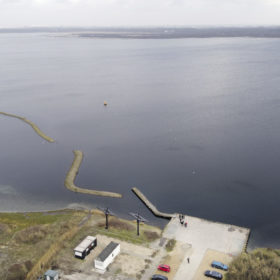Rooftop downturn looms with lockdowns
With its large and mature small-scale rooftop solar segment, market observers watched Australia closely for the impact of Covid-19 lockdowns in March and April. Early sentiment, evident in a pv magazine Australia and Green Energy Markets survey does not bode well – however installation data indicate that a downturn in installation volume has yet to materialize.
The sea is the limit
Two new test facilities are looking to expand PV’s reach beyond the constraints of land and toward the open ocean. And if the steep learning curve from freshwater floating PV installations is anything to go by, the data produced at the test beds will prove invaluable.
New energy ecosystem, cost down, utility-scale
SolarEdge has faced a difficult 12 months, with the untimely passing of its highly respected CEO Guy Sella in 2019, ongoing IP disputes, and the Covid-19 crisis impacting production. Lior Handelsman, the VP of marketing and product strategy and the founder of SolarEdge, says that despite these challenges, the company’s work continues, and Sella’s name lives on.
Solar resiliency, still a tough year
There is nothing like a crisis to make a forecaster’s job both vitally important and impossibly difficult. But as the worst shock of the Covid-19 pandemic begins to pass, a sense of the impact on the solar sector is becoming clear. pv magazine recently spoke to Jenny Chase, the head of solar analysis at BloombergNEF, on the implications for PV of these unprecedented days.
Gallium in the fight against LID
From the acquisition of IP to commercialization, the PV industry has witnessed a rapid rise of gallium-doped silicon. Researchers are testing the resulting cells’ stability while industry has begun the manufacturing phase. All this leads to a key question: Will gallium doped silicon solar modules will be the next big thing?
Criteria and implications for gallium-doping
As a remedy for light-induced degradation (LID) in crystalline silicon cells, gallium-doped wafers are showing considerable promise. With reports that ingot growth productivity can rival that of boron doping, it seems that gallium doping may now be able to meet the cost, integration and performance criteria that have informed solar manufacturing technology adoption, writes Alex Barrows, senior research analyst at U.K.-based consultancy Exawatt.
‘There will be no slowdown in capacity expansions’
Innovations in the solar industry often have a trickle-down effect. Suppliers need the ability to adapt quickly to new developments elsewhere in the market and ensure that they can move with the times. Nowhere is this more apparent than in the flashing equipment space, where in the last few years alone, bifacial and new wafer formats have quickly changed the shape of inline testing. pv magazine recently caught up with Stefan Schubert, project manager at German flasher supplier h.a.l.m. Elektronik GmbH, to discuss the latest developments in this space.
Perovskites continue to clear hurdles
As laboratory world records attest, perovskite PV continues to develop at pace, and Helmholtz-Zentrum Berlin (HZB) is responsible for many such records. Rutger Schlatmann, head of the renewable division at HZB, sets out how, beyond efficiency, a number of key obstacles to commercialization are being steadily overcome.
TCO for passivated contacts
Transparent conductive oxide layers are commonly used in some forms of thin-film PV manufacturing, and in flat panel production. A new project, funded by Solar-Era.Net, is investigating its use in passivated contact crystalline silicon solar cell production. Lennart de Vreede and Thomas Aukes Solmates, a pulsed laser deposition equipment developer located in the Netherlands, outline the project.
Tile for more cells
Panels featuring tiling could be one of the most innovative module-level technologies to enter into commercial-scale production in 2020. The premise is simple: Squeeze more half-cut cells into the module for an efficiency and power output boost. But it’s not entirely straightforward, and similar approaches such as shingling have a significant head start.










